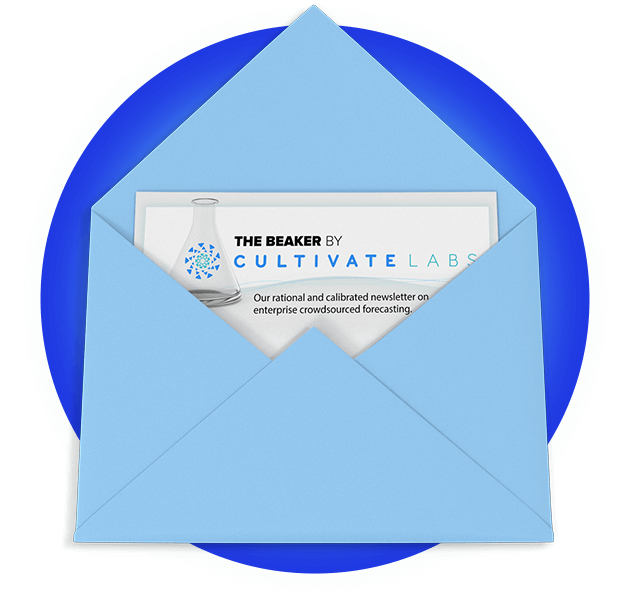Team forecasting lessons from Cultivate Labs
By Faith Powell on October 05, 2023
There are significant benefits to forecasting in a team setting, including improved accuracy. When approaching a forecasting problem as a team, multiple perspectives and areas of expertise come together to generate more comprehensive and thoughtful forecasts. This is why we encourage teaming within Cultivate and on many of our client forecasting platforms (e.g. Pro Forecaster and Team Lead programs on INFER).
As a company, we hold small group forecasting sessions regularly and are active on our client’s public forecasting sites as the “Cultivator” team. We get together virtually for half an hour each Friday to discuss and forecast on a specific question. Over the course of those group forecast sessions, we’ve learned a few tactics to help other teams surface diverse viewpoints and avoid groupthink. Here are some recommendations for any teams forecasting together:
1. Hold a standing meeting time and designate a meeting "lead" to select the forecast question and facilitate the discussion.
At Cultivate, we’ve designated a lead who selects and circulates the forecast question to the group Friday morning in advance of the forecasting session. Although research beforehand is not required, this allows team members to give some thought to the question or do some quick digging, if the topic is unfamiliar, before coming together to discuss. Once we’re in the session, Cultivators will verbally share initial thoughts and reactions to the question, discuss the background information, review recent crowd commentary, consult the current crowd forecast, and conduct individual research on the spot and share relevant information with the group.
2. Bring in additional team members or outside experts to provide an external perspective.
Even if an “expert” perspective is not available, make sure your team brings unique backgrounds to the table. We forecast together as Cultivate engineers, designers, consultants, interns. Each one of us brings our own expertise, knowledge, and personal interests that help us evaluate a forecasting question from different angles, or consider certain factors we may not have on our own.
3. Embrace silence: Take breaks periodically so people can think independently vs. constantly discussing as a group.
While much of the session is dedicated to discussion, we often sit together in silence conducting independent research. Usually, one Cultivator will find relevant base rate data and share it with the other forecasters. We draw on current data, reporting, and other research to discuss the range of possible scenarios. Remember to embrace periods of silence and encourage team members to take breaks periodically from collaborating as a group to think independently – this often reveals critical and creative contrarian viewpoints.
4. Make sure someone plays devil's advocate – challenging group assumptions and logic.
Make it comfortable for team members to challenge each others’ hypothesis and express different sides to arguments. Cultivators will put forth and debate hypotheses, and generate multiple scenarios for what is or is not possible. The resulting dialogue often exposes blind spots and help to reevaluate underlying assumptions.
5. Keep politics, egos, and power dynamics out of the forecasting process as much as possible.
Pay attention to who is regularly and actively engaged in the forecasting process, and encourage participation from those who are less active or who might be taking a back seat. Our Cultivate sessions are informal. We brainstorm on the spot; some people may be well-versed in a topic and some might know nothing about it and treat the session as their time for research. Regardless, this structured but laid-back approach to a discussion keeps us coming back for more and is ultimately part of the path towards improving analytical rigor and accuracy.
6. Encourage team members to quantify their perspectives and detail nuances in their rationale to inform research for team members and other forecasters.
By the end of our session, Cultivators will vocalize their individual probabilities and compare their estimates with other teammates. Team members openly share what they are forecasting and why to help summarize information from the session. The reasoning behind the forecasts are documented independently in rationales and pre-mortem inputs on the forecasting platform.
7. Individually, keep monitoring and updating forecasts after group forecasting sessions.
After the group forecasting session, encourage team members to return to past questions and update their forecast based on new information and changing views. Looking back at previous forecasts allows continued opportunity to refine forecasting approaches and improve future results as a team. Cultivators help one another in monitoring the question topic by sharing related updates and articles through the team discussions on Cultivate’s forecasting platforms or on our company Slack channel.
Our Cultivate team has found a lot of value in these forecasting sessions – we’ve seen collective and individual performance improvements. We’re able to practice how we collaborate with one another, how to make judgments rationally, and stay open-minded to new ideas and information – all important characteristics that build solid forecasting aptitude.

